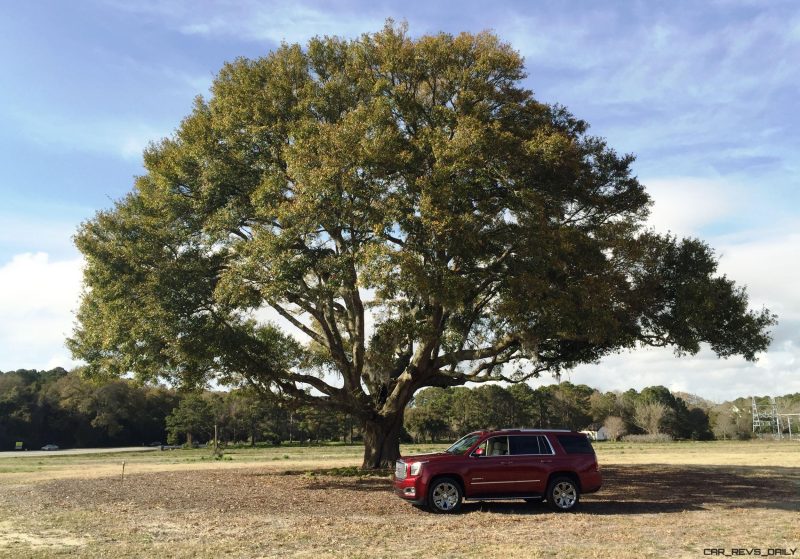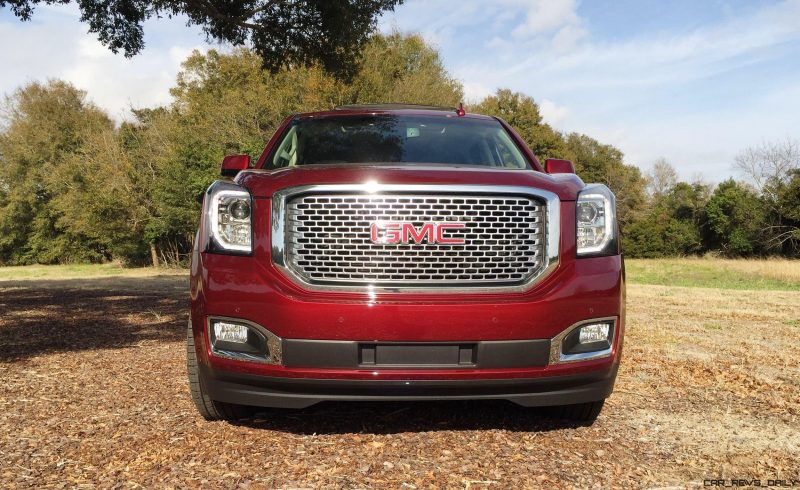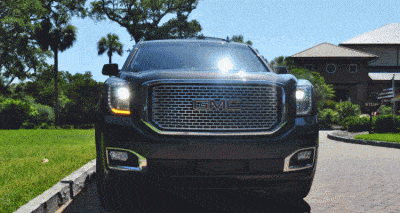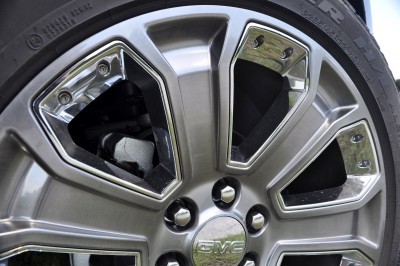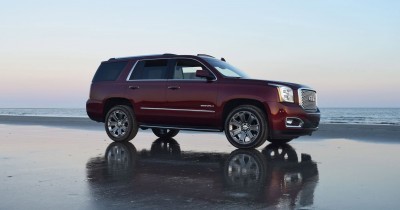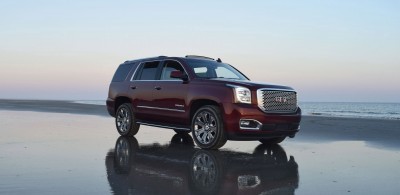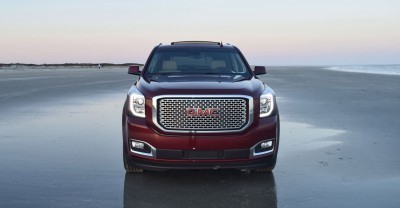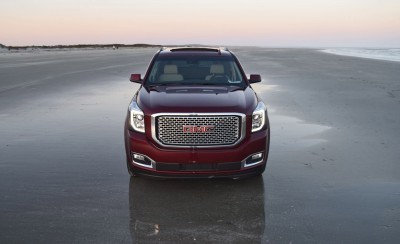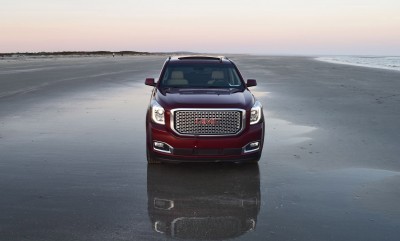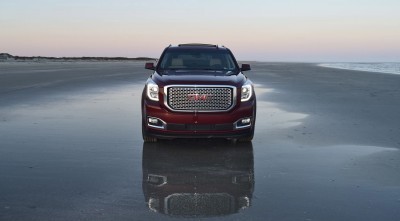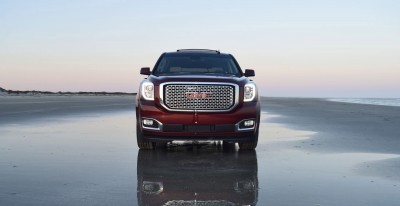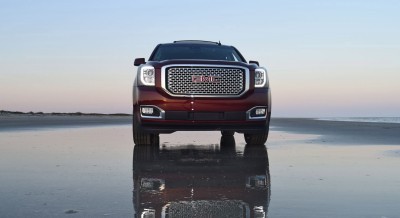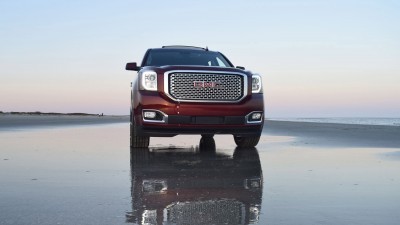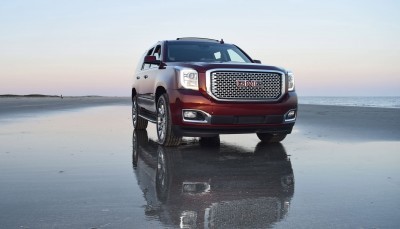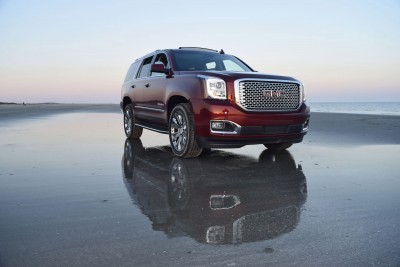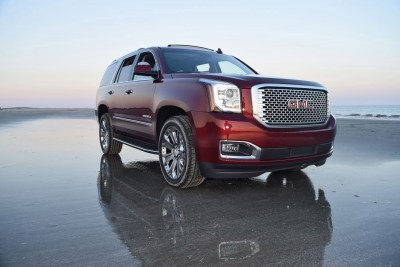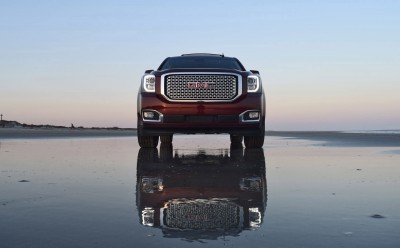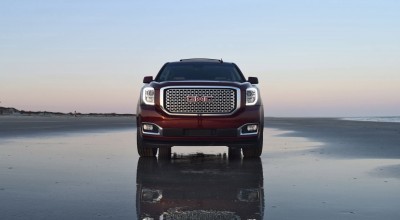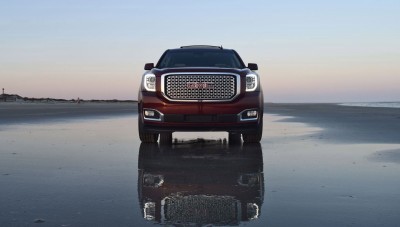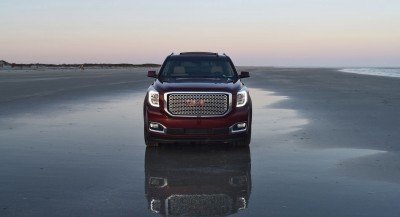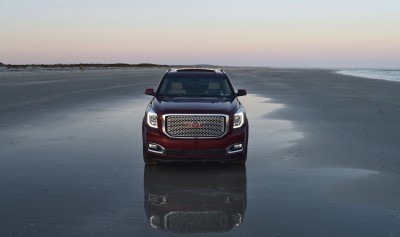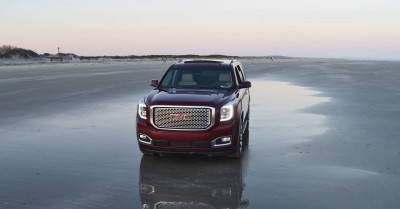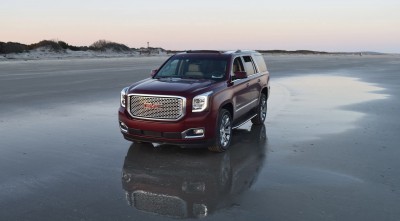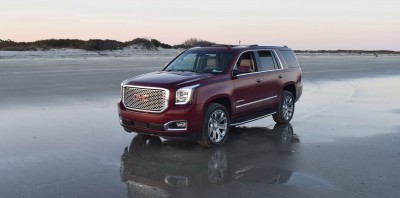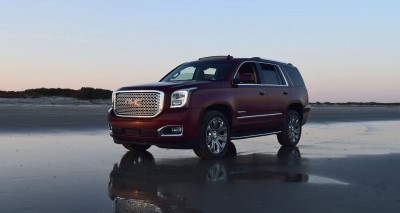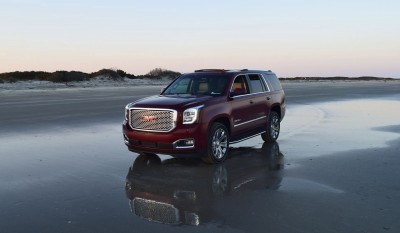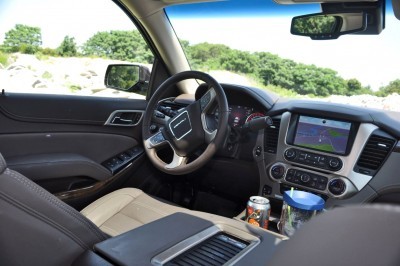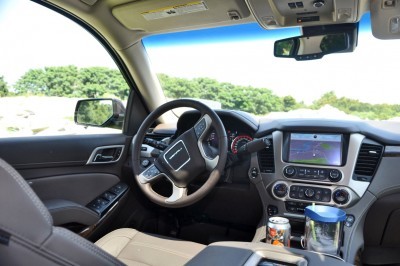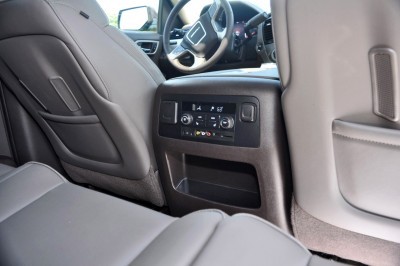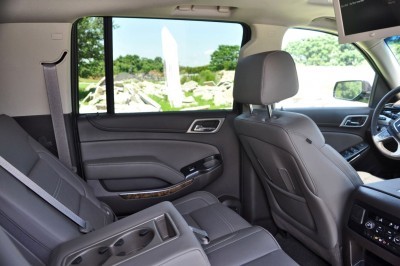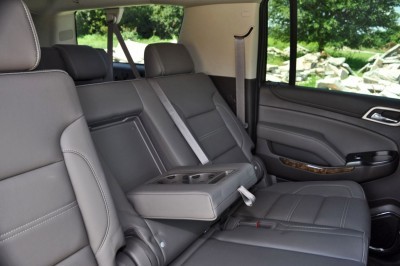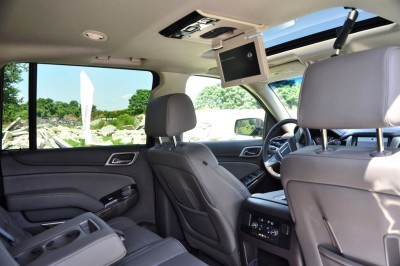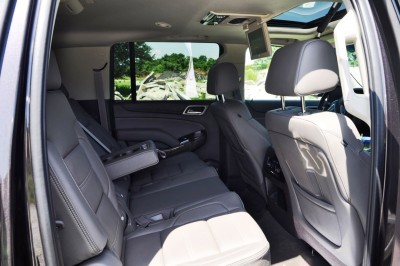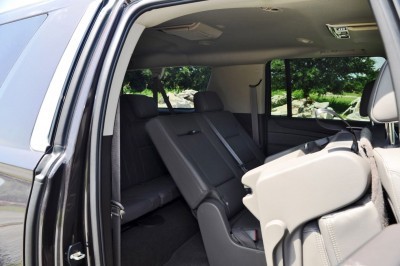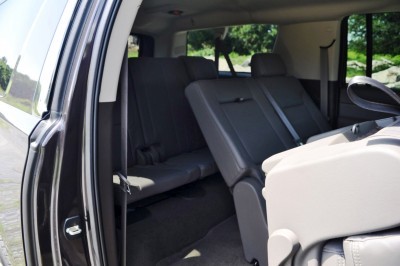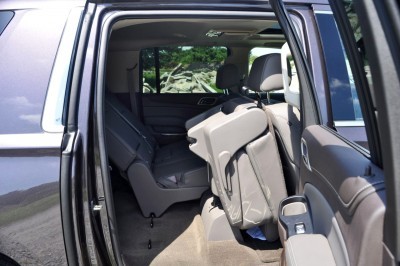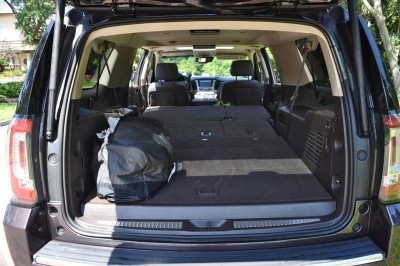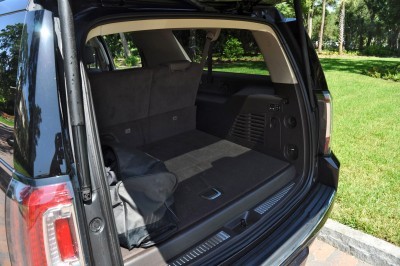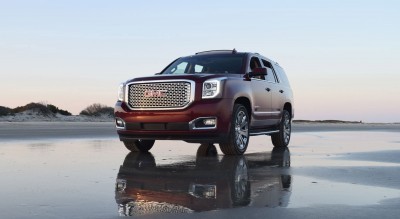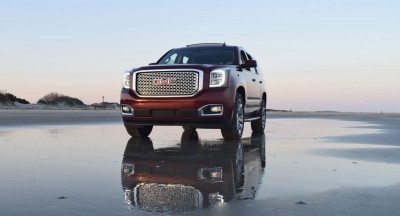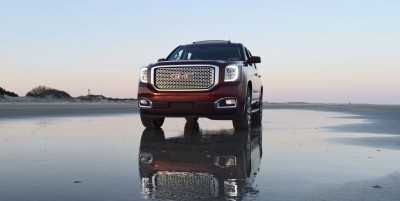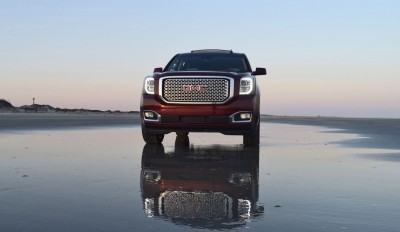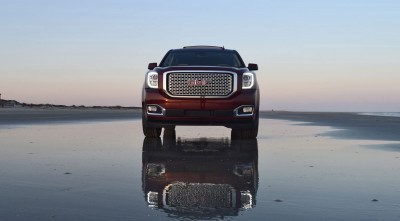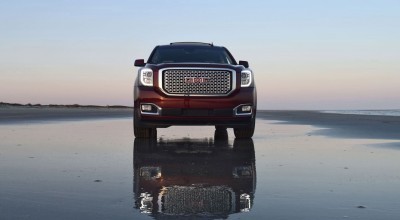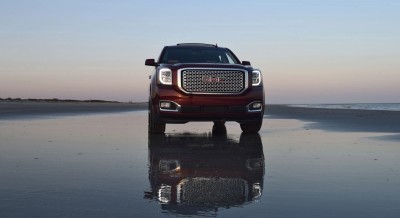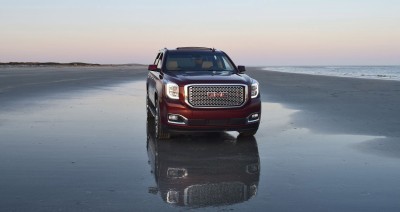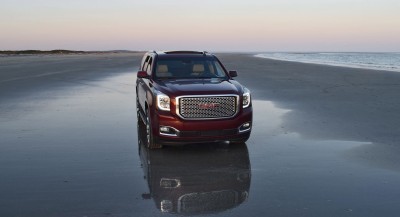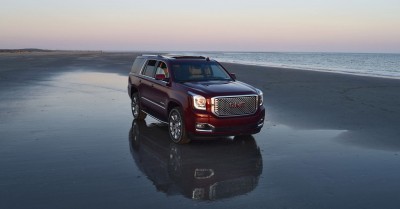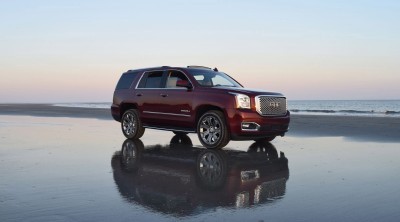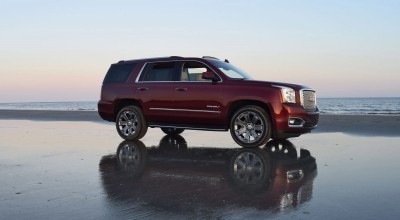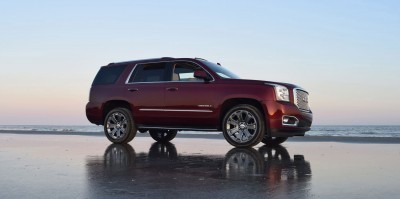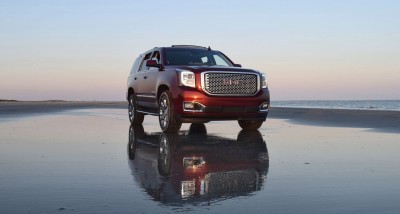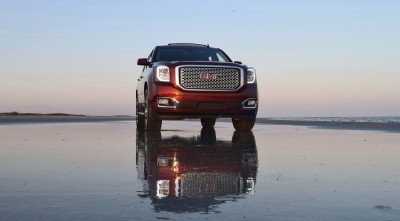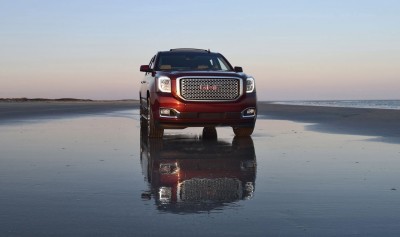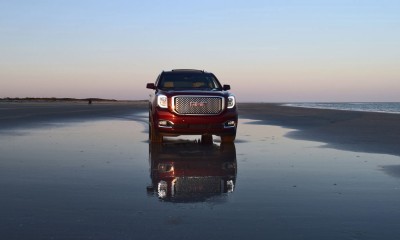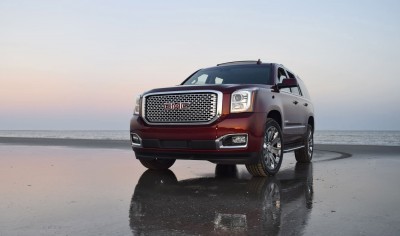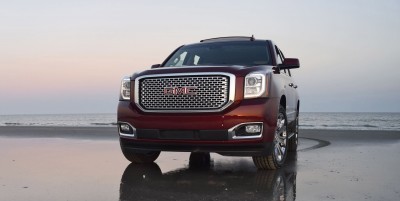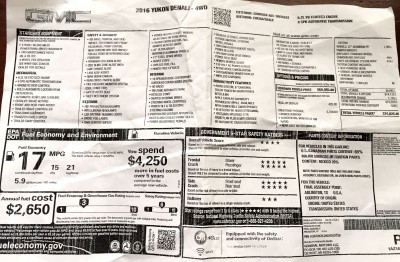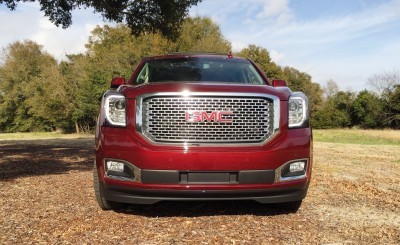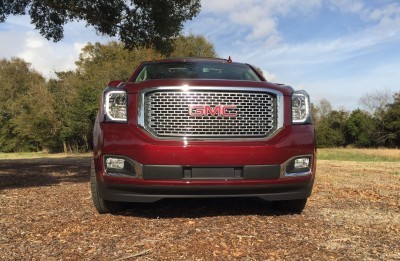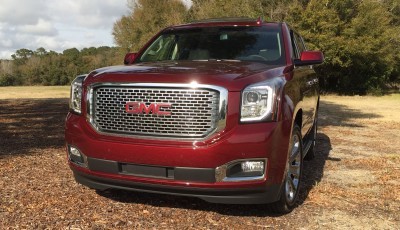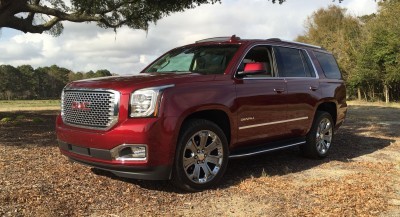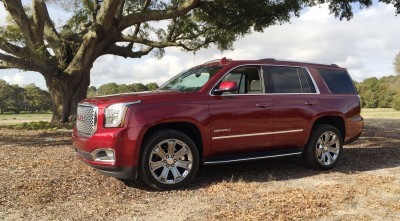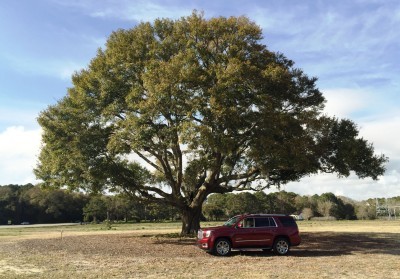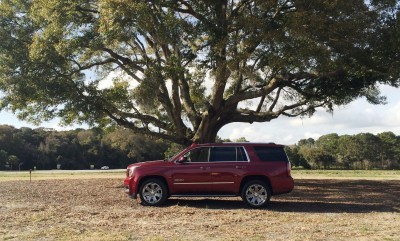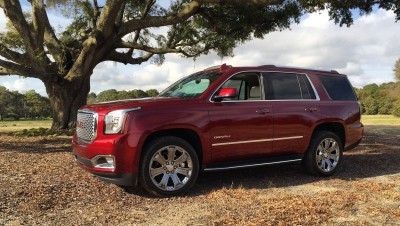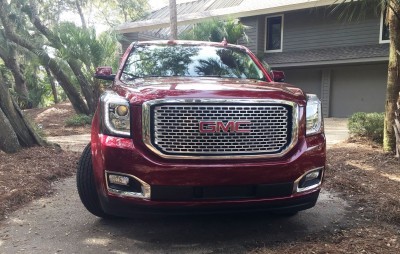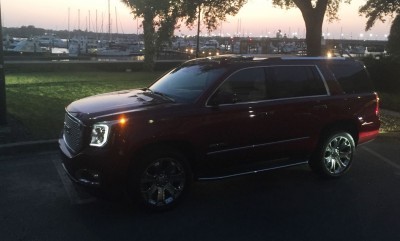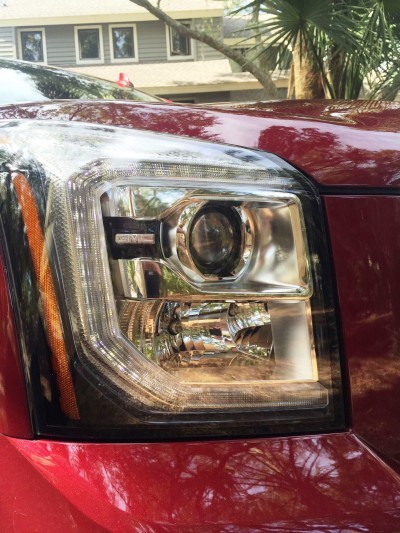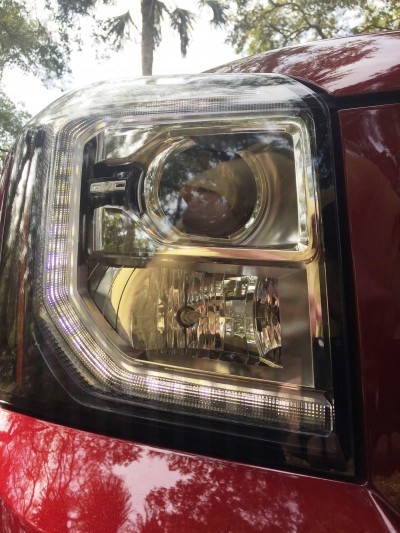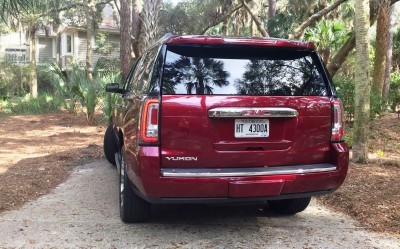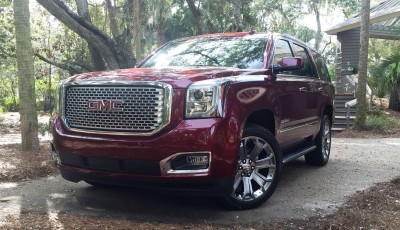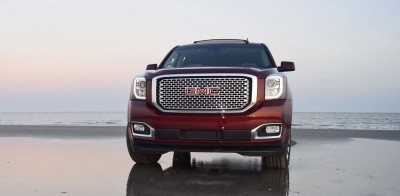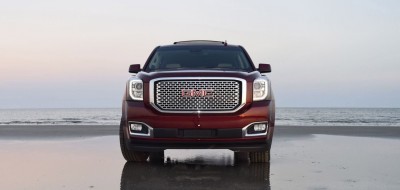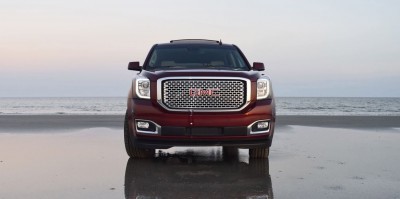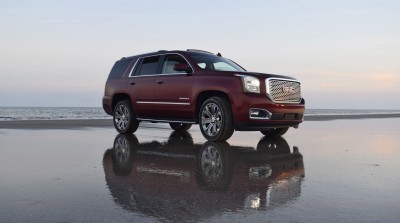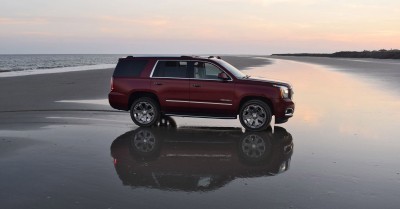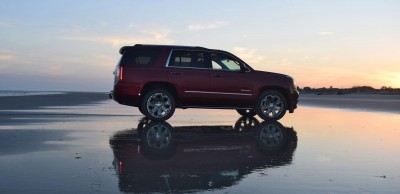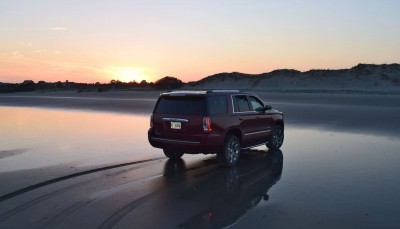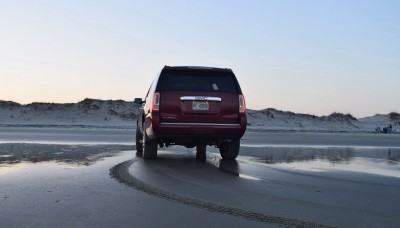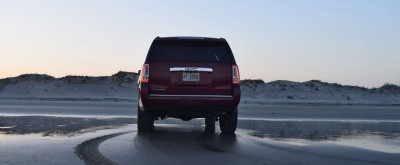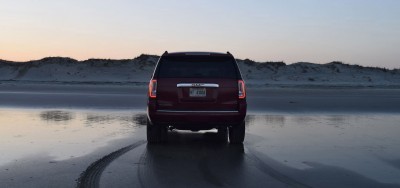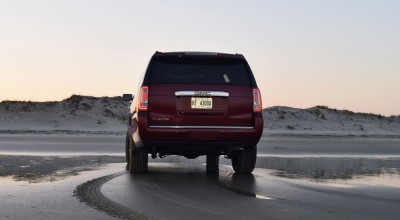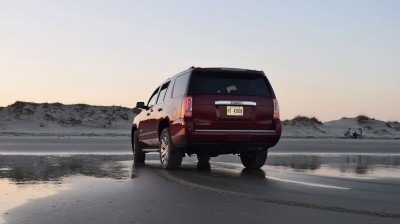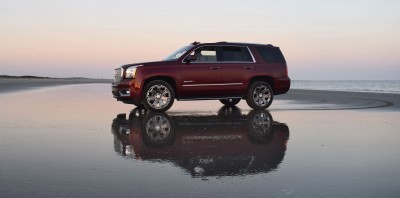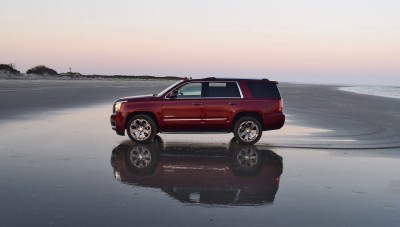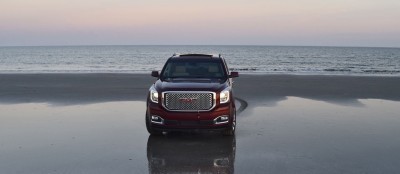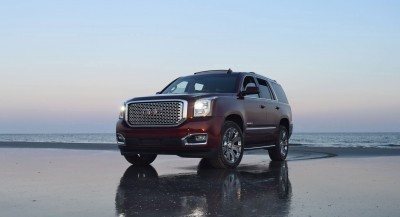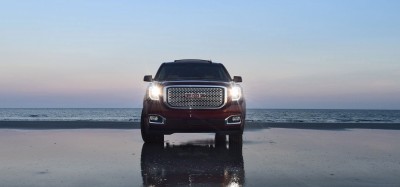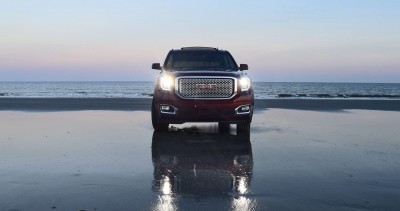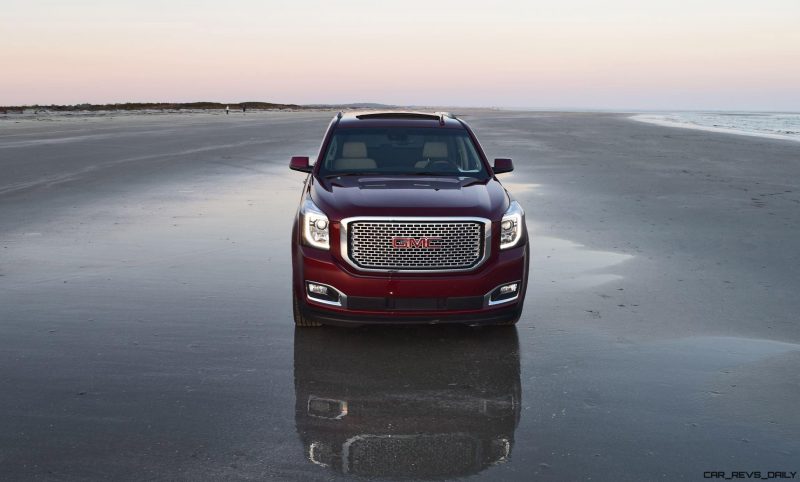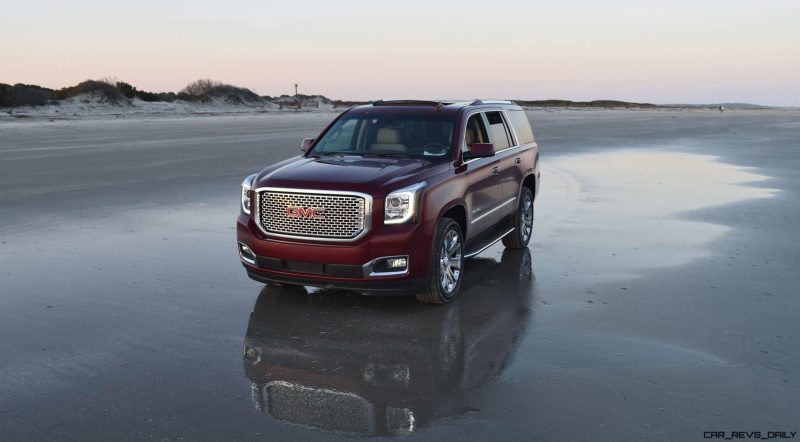GMC unknowingly timed their full Yukon redesign perfectly: as the new full-size trucks arrived in 2015, gas prices dropped to historic lows. Rave reviews on the new trucks’ style, tech and performance propelled massive sales gains: nearly double the sales of the overall vehicle, and almost tripling the previous year’s Yukon XL sales.
These are still down from their heady highs in the 70k-units-plus annual tallies that evaporated after 2008’s gas-price spike.
There is much more to the success of the Yukon Denali than external factors like gas prices., however. This lux truck is a perfect sweet-spot between yummy mommies, cool dads, flush athletes and wealthy adventurers of all stripes.
Is the magic formula still in effect for the 2016 Yukon Denali 4WD, with its standard eight-speed automatic and updated infotainment with Apple CarPlay?
Oh yes, it is. This giant machine makes anyone feel like a winner behind the wheel. A classy option for those who reject the Escalade’s pretension, but demand more fast-lane cache than any Chevrolet can deliver.
That being a widely-known fact, we have identified a few places where the Yukon Denali should up its game — even with its red-hot brand appeal, improved eco skills and maintained toughness for towing, hauling and climbing mountains near and far.
Standard headings of Exterior, Interior, Performance, Pricing and Summary are joined by 80 beautiful photos and a pair of HD drive reviews. These videos are of the Yukon Denali XL, whose full review in the 2015 model-year is over at this link.
HD Drive Video
EXTERIOR
The style of the new Denali is still quite premium, advanced and deeply impressive on the road — even as the Texas factory is working three-shift, 24-hour-a-day rush schedules to make as many as possible for at least the last year.
The coolest and best parts of the Denali come from its unique nose and tail versus its siblings. This nose is brighter in Denali form than the fairly basic look of the standard Yukons from their $48k starting prices.
A bright chrome outer grille is beveled cleanly at its edges, and matches the look of the foglamp shrouds down below. Projector HID low-beams are high-mounted within a socket-wrench-shaped LED DRL as standard. These glow bright and proud on the road in nearly every headlight mode, including full Automatic. The same can’t be said of the new Ford Expedition’s LED foglamps in top trims: that truck needs its parking-lights on to have any LED glow on the street.
These LEDs set a nice tone for the upgrade over the very-dull execution of the nose LEDs in the top Suburbans, yet are clearly less shouty and show-off-ish than those full-height LED DRLs up the edge of the Escalade’s cheeks.
The technical inner grille of the Yukon Denali is a subtle, matte silver stack of chunky rectangles. It looks strong, premium and serious. And it is!
As are the halogen highbeams and foglamps. Despite not matching the white/blue of the other lights up top, these provide good light output and great visibility on par with premium German sedans. That is certainly new for a value-priced American truck!
The Yukon Denali comes standard with 20-inch wheels, but is upgraded to some really cool 22-inch alloys for a $2k option on the test truck. These wheels are awesome as standard, and even better for DIY and customizers. Why? The painted wheel inserts can be removed by a simple Allen wrench, then painted a darker grey or perhaps gloss black. Few cars or trucks make their customizations so easy and simple. No need to remove the wheels from the truck to respray them a more unique, likely darker, and trendier shade.
In addition, the yellow-ish halogen bulbs could be swapped for HID or LEDs fairly easily on a DIY basis for owners. Perhaps GMC should consider upgrading these themselves, however. Many buyers would stump an extra $2k in sticker price for the ultimate in high-viz, high-tech lighting. The Yukon Denali does rock LED blinkers up front and in back, though. Proving the GMC crew loves LEDs as much as we do!
Around the profile of the truck, the Yukon Denali is also quite premium and appealing. It rides fairly low on its boots, and the 22’s fill out the giant fenders nicely. Much better than the standard 18s of the Yukon without many Denali features, or a la carte options on the regular Yukons.
The main difference in the profile views of the Suburban, Escalade and Denali come from the window-edge brightwork and lower sills. The Denali wears fixed running boards, while the Escalade has power-retracting units. The Suburban typically rolls with none at all.
The retractable units are the best visually, and for sheer ability off-road or in deep snow, where these fixed, full-length steps can get caught in muck. They are most useful in back, for kids, and for anyone entering the third row of seats.
In the tail, the Denali is defined by its high-status badges and clean new LED combination taillamps. Beyond a body-color bumper as standard, it is hard to pinpoint much original design back there that is not shared with the Suburban. Luckily, you eye is drawn to what is new.
The crescent-shape of LED main light is sharp and classy. A world away from the hideous clear GMC taillamps with red blobs from the previous generation, that is for sure.
In all, the style of the Yukon is one of its best selling points. It is clearly very, very new and very, very expensive. But not as pushy with its price or tech as the Escalade. For many, this is the right balance.
The bonus of subtle luxury? We did not fear being robbed or having the machine stolen while driving it, which could not be said of piloting an Escalade in gritty urban areas.
INTERIOR
The cabin of the Denali is definitely its second offensive strength. Everything is standard, or so it feels looking at the spec sheet and the dozens of control buttons for nearly every seat in the house.
Eight Nine is the max seat-belt count, by the way, but most will forgo the standard front bench seat of the Yukon in favor of the twin buckets. That drops us to eight with bench seats for row tow and three. And down to seven with the twin captain’s chairs in the second row versus an available bench there too.
The big score of all these seats in the Denali or Denali XL is that they are not mini jump-chairs, like in the Land Rover LR4’s wayback. These are all fully-padded and reasonably comfortable for long trips. The second row of this new-gen Yukon is much larger than before. More leg and shoulder room is notable, as is the extra toe and knee room in the third rows. We don’t believe there is a legroom hit from choosing the regular length models, either, versus the XL versions.
A final pair of seating innovations help the big Yukons compete with their soft-road, crossover rivals much more effectively. These are the quick-tumble second row that lets people hop in the third row without scaling the seatbacks. The next is the power-tumbling controls in the cargo bay. Pop these four toggle switches to their fold mode, and you finally have a fully-flat load area without any drama or heavy lifting. Only the third row has a power-operated lift direction too, but the second row is easy to flop back into place with the side doors open.
Along with the speedier and less-cargo-robbing power open/close tailgate, the Yukon Denali (and its siblings, mind you) are all much easier than ever to load up with cargo and head out for an adventure.
If cargo AND people are your demands, though, the Denali XL is much stronger than the shortie. To have family-sized cargo room, but all seats in place, the XL is the only hero. The trunk of the regular Denali almost demands at least one, and likely both, third-row seats be folded down to make room. Luckily, that power-folding third row is split 50/50 to do just this trick. Even so, the XL is only about $3k more expensive. For those with big families, the XL is a clear winner. Only a tick slower, and a tick thirstier. But much more useful overall at its 8-man adventure missions.
Denali XL Shown
INTERIOR OPTIONS:
The test Denali only includes a handful of options. Mostly because everything imaginable is included as standard. Even so, a $425 head-up display is one of the best on the market. Configurable to show speeds, nav instructions, entertainment details like track/artist name, and even a tachometer for performance buffs. It is a full-color unit and better than one recently sampled from Lexus or Jaguar.
Next, the Open Road Package, which costs just above $2k (with a $500 incentive added). This Open Road pack brings a small moonroof for the front row of seats, a rear-seat entertainment system, and a full year of SXM satellite radio trial.
The biggest gripe that backseaters will have in the Denali is an oldie, but a goodie. It is choppy back there over bumps sometimes. And always has been. It is less bumpy than ever before, and now much quieter with far better HVAC. But over railroad tracks or big potholes, those in the third row still feel the suspension hop down below — in a way that is almost imperceptible up front. Especially versus the old days of just five-years-ago’s Tahoe, etc.
PERFORMANCE
The GMC Yukon Denali’s third ace is its standard performance drivetrain. This 6.2-liter V8 and the new eight-speed auto is shared with the Escalade, but with no Suburbans at any price. The jump from the 5.3L V8 up to this 6.2L brings big improvements in low-end torque, a throatier exhaust bellow, and better speed at all times. For near-zero demerit in fuel economy. Triple-win!
460HP is a stout total, and beats the Nissan Armada, Toyota Sequoia, Ford Expedition or Lincoln Navigator — many by big margins. This drivetrain is more responsive and sophisticated than ever for the Denali. A part-throttle jab no longer calls up a giant downshift and lunge forward a few moments later. The new GMC Denali is also to pick a ratio just a bit speedier when needed. It makes the drive experience much smoother and more controlled, especially for fast drivers.
The new eight-speed makes the pure launch about a half-second quicker than before, when this engine paired to a six-speed automatic.
HD 0-60mph Launch Video
Is the Denali standard-length notably quicker or more eager in corners than the XL? No, it is not. They feel almost exactly the same on the roads. Slightly more ‘junk in the trunk’ via the XL length actually balances the handling a bit better than the normal trucks can manage, at least without a load of people or cargo in back to smooth things out.
And here come our two main gripes about the Denali’s performance:
— the ride is hard. Period. A live axle in back is still jumpier and more shuddery over bumps than the independent rear ends of the Ford Expedition or Infiniti QX80. One-wheel bumps or potholes in those trucks cause barely a fifth the subjective clang or disturbance of the Denali in the same scenario.
The tire pressures matter immensely to ride comfort in all new Tahoe, Escalade and Yukon trimlevels. With big wheels, the overinflated tires make a lumpy ride downright choppy. Look in the driver’s doorjam for the sticker showing the proper air pressures all around. The TMPS, while good and 4-wheel, does not give any warnings when the tires are overfilled.
When they are at the proper inflation, the handling becomes much more trustworthy. The steering is more accurate, and the brakes do not cause the truck to wander on in hard stops. With overfilled tires, all these bad traits are front/center all the time.
EVEN with the right air pressures and magnetic shocks, as standard on the Denali, it rides pretty rough. Certainly much, much rougher than the QX80 and the Navigator, that is for sure. Not to mention a Mercedes-Benz GLS 7-seater or a Range Rover LWB, whose pillowy comfort is at least 5X better than any Denali or Escalade.
Flipside of a hard ride? Great handling!?
Yes, the Denali hangs on gamely around corners. It is confident in most highway drives, even in the mountains, thanks to the wide sport rubber and optimized suspension all around.
In this drive scenario, though, the Denali cannot keep it all floored without a really fearless pilot. Why?
The seats have almost no lateral support, are slippery, and generally do not hold you in place in fast bends. At the end of the day, the bouncy chop of the ride PLUS loosey-goosey drive position conspire to make the Denali driver want to slow down.
Way down.
We’d suggest GMC (or owners on an aftermarket basis) either calm down the suspension firmness dramatically, and/or offer a lower and more enveloping drive position to make the most of the stiff springs. As it is, the truck likes mellow, wide highways with a heavily-laden cabin or a trailer in back. Then, it finally breathes through bumps and is chill around corners. One-up and on twisty roads? Denali prefers slow inputs and smooth, slow cornering speeds. Any Range Rover or X5 cornering speeds in the Denali will make your passengers mutiny.
But even one-up, the Denali does not love to be driven fast around corners. It really needs 4-Auto engaged to avoid wheelspin from 2WD mode.
We wished dearly for a “Sport” mode like the Escalade-exclusive drive modes. (Or a comfort mode? Yes, Escalade has this too; but still rides too hard for our calmer-mood tastes.) A Denali Sport mode could quicken the slow-but-accurate steering rack, juice the (pretty lazy) throttle response and generally make corners less challenging. We also wish for shift paddles in the future, versus the column-mounted “+/-” gear-selections that are tailored mostly to towing.
PRICING
The Denali trimline is said to make up at least half the Yukons sold every year. This is a strong proof of the Denali badge appeal, for sure, and also a factor of making everything standard. The chock-full spec sheet is ideal for American car shoppers, who still prefer to buy off the lot versus ordering one special.
We can’t really blame the logic, though. The Yukon SLE and SLT trims need dozens of options to be anywhere near the Denali equipment levels, and then they still lack the exterior goodies of the Denali trucks.
The Yukon Denali seems like a pricey selection: its base price of $65k is up almost 20 grand over the base Yukons. With 4WD, our tester came in with a base price of $68,045. With a few options detailed on the window sticker, the price is $74,825 out-the-door.
Yes, yes. Super steep, you might say. But consider a Tahoe LTZ for $69k, or an Escalade Platinum for $99k. In this universe, the Denali is fairly good value.
SUMMARY
Denali is the sweet spot of the General Motors large SUV lineup. This is a proven fact: it has sexy and modern design elements outside, a plush and loaded cabin inside, and a top-flight drivetrain missing from all Suburbans, and cheaper Yukons.
Perhaps because the 2016 Yukon Denali has come so far on all those metrics, we’re only left slightly bittersweet on what could have been. Or perhaps what may come one day.
We think Denali Sport is a sweet evolution of these giant trucks in the future. Leverage the ladder frame, auto-locking rear diff and auto load-leveling suspension … to greatness!
Imagine a Yukon Denali in a darker, more sinful light: dark trims, loud dual-mode exhaust, sticky sport seats and smaller, paddle-shift-equipped steering wheel!?
At the end of the day, it would still be a trailboss and family hero. Ready for surf and turf, year round.
We just wish the 2016 model made the most of its strong powerplant, chassis, style and tech… with just one rockstar on board!
Price and compare the GMC Yukon trims, colors and options over here…
http://www.gmc.com/yukon-family.html

Tom Burkart is the founder and managing editor of Car-Revs-Daily.com, an innovative and rapidly-expanding automotive news magazine.
He holds a Journalism JBA degree from the University of Wisconsin – Madison. Tom currently resides in Charleston, South Carolina with his two amazing dogs, Drake and Tank.
Mr. Burkart is available for all questions and concerns by email Tom(at)car-revs-daily.com.


